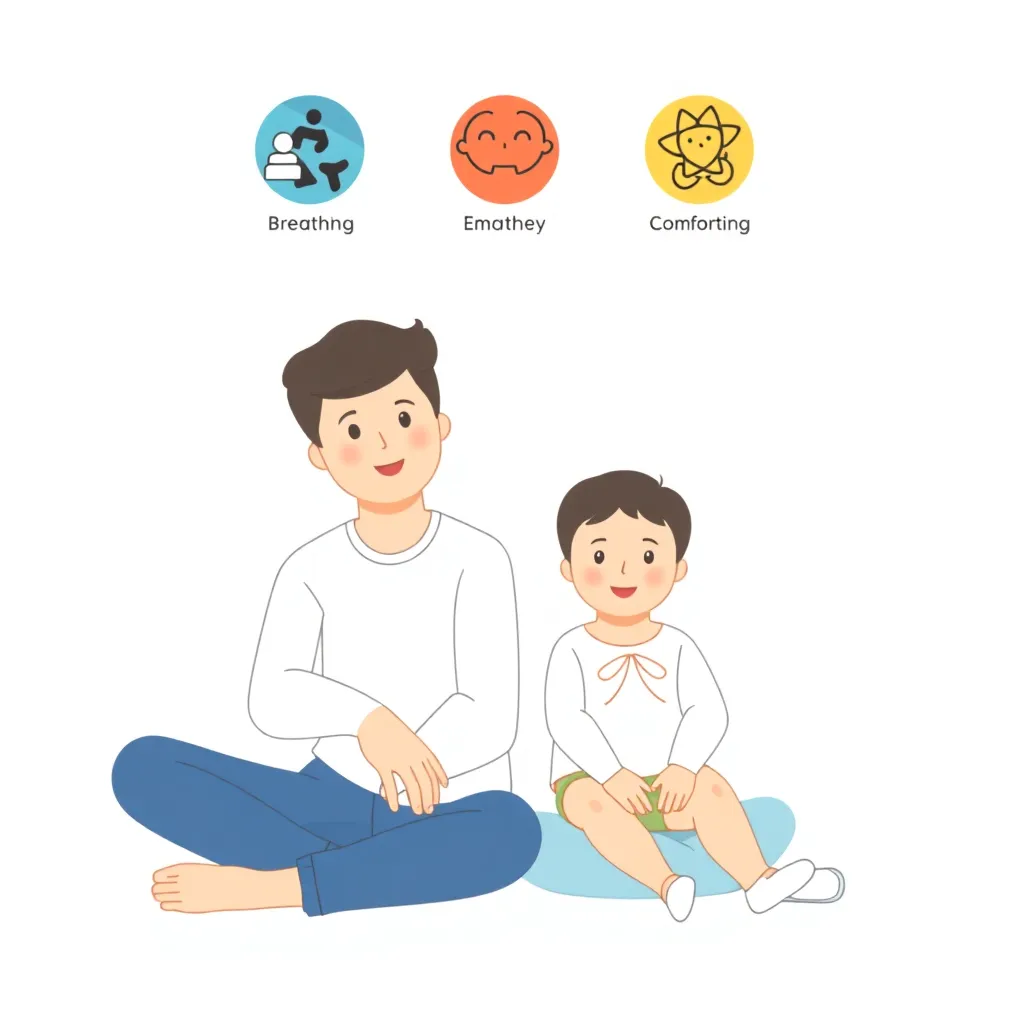Ever had one of those days where your toddler’s meltdown feels as intense as a summer thunderstorm? We’ve all been there, and you’re certainly not alone. It’s a phase packed with raw emotion that can leave any mom feeling a bit overwhelmed. But here’s the good news—you’re in the right place to find some comfort and practical tips.
Welcome to She Is A Good Mommy Blog, where we dive into the heart of toddlerhood and help each other navigate these big feelings. Understanding why these emotions matter not just to your little one but to your whole family is key to creating a nurturing environment. In this article, you’ll discover five insightful steps to help your toddler manage their big emotions, turning those stormy moments into opportunities for growth and connection.
Stick around, because these strategies might just transform your daily routine into a more peaceful experience. Trust us, you’ll want to save this one for those challenging days!
1. Practice Deep Breathing

When your toddler’s emotions start to bubble over, guiding them through deep breathing can be a simple yet powerful tool. It’s a strategy that many moms, including myself, have found incredibly helpful. Imagine you’re in the grocery store, and your little one is on the verge of a meltdown because they can’t have their favorite snack. Instead of reacting with frustration, try getting down to their level and gently encouraging some deep breaths together.
Here’s how you can practice this at home:
- Start by sitting comfortably with your toddler. Invite them to place a hand on their tummy.
- Take a deep breath in through the nose, holding it for a second, and then slowly exhale through the mouth, like blowing out a candle.
- Repeat this process together, making it fun by counting breaths or using a favorite stuffed animal to demonstrate the rise and fall of breathing. 🌟
Not only does this technique help your child calm down, but it also gives you a moment to collect your thoughts. Plus, it’s a wonderful way to model healthy coping mechanisms for your child.
Remember, patience is key. The more you practice together, the more natural it becomes. Celebrate every small win along the way, knowing that you’re equipping your child with tools that will serve them for a lifetime. 🌈
2. Create a Calm Corner

After practicing deep breathing, consider setting up a calm corner in your home. This dedicated space can help your toddler process big emotions in a safe and comforting environment. Imagine a small nook with soft cushions, a few favorite stuffed animals, and a cozy blanket. Add some books about feelings and maybe a sensory toy or two. This isn’t a timeout spot; it’s a haven for emotional self-regulation. 🌈
Take Sarah, a mom of two, who noticed her toddler would often become overwhelmed in busy settings. She transformed a corner of the living room into a calm zone. Whenever her little one seemed upset, they’d head there together to unwind. Over time, her toddler began using the corner independently, showing growth in emotional management.
Here’s how you can set up your calm corner:
- Choose a quiet, comfortable spot in your home.
- Include soft textures and calming colors.
- Add items that your child finds soothing, like favorite toys or books.
- Keep the space inviting and free from distractions.
Creating this special space not only benefits your child but also offers you a moment of peace, knowing your toddler is learning to manage their emotions. Remember, every small step counts, and you’re doing an amazing job! 🌟
3. Use Feeling Words

Incorporating feeling words into everyday conversations can be a game-changer for both you and your toddler. Imagine your little one having a meltdown because their tower of blocks just toppled over. Instead of just giving a comforting hug, you might say, “I see you’re feeling frustrated because your tower fell. It’s okay to feel that way.” By doing this, you validate their emotions and give them the vocabulary they need to express themselves next time.
To start, try labeling your own emotions throughout the day. Say, “Mommy feels happy because we’re playing together,” or “Daddy is a bit tired today.” This not only normalizes talking about feelings but also models emotional expression.
- Label feelings during storytime. “Look, the character feels sad because they lost their toy.”
- Encourage your child to describe their own feelings: “What do you feel when we can’t go to the park?”
- Use a feelings chart with faces and names to help them identify and choose how they feel.
Teaching your toddler to use feeling words not only helps them articulate their emotions but also strengthens your bond as they learn to trust you with their feelings. This small step can lead to big improvements in their emotional regulation, paving the way for a more peaceful home environment. Remember, every little step counts in nurturing your child’s emotional growth. 🌈
4. Read Emotion Books

Exploring books about emotions is a wonderful way to help toddlers understand and articulate their feelings. Many children’s books are designed to describe emotions through engaging stories. Picture books like “The Color Monster” or “Today I Feel Silly” offer vibrant illustrations and relatable scenarios that capture a toddler’s attention while gently introducing the concept of emotions.
From a mom’s perspective, setting aside time to read these books together can be a bonding experience. ✨ As you read, pause to ask questions like, “How do you think the character feels?” or “Have you ever felt that way?” These discussions encourage your child to connect with the characters and reflect on their experiences.
Here’s how you can incorporate emotion books into your routine:
- Choose a cozy spot and a regular time for reading, like after lunch or before bedtime.
- Engage your toddler by using different voices for characters and pointing out facial expressions.
- After reading, recap the story and discuss any emotions that stood out.
Reading emotion books not only enhances your child’s emotional vocabulary but also strengthens your bond, fostering a safe space where they feel understood and supported. Keep exploring these stories together, and remember, you’re building a foundation for empathy and emotional intelligence that will benefit your child for years to come. 🌈
5. Model Patience Daily

As you explore the world of big emotions with your toddler, remember that your actions often speak louder than words. Modeling patience daily is a powerful tool for teaching your little one how to handle overwhelming feelings. Picture this: You’re in the middle of preparing dinner, and your toddler starts to demand attention. Instead of reacting with frustration, take a deep breath, pause, and calmly address their needs. This simple act of patience sets a tangible example for them to emulate.
Here are some actionable steps to practice:
- When you feel stressed, verbalize it: “I’m feeling a bit stressed right now, so I’m going to take a deep breath.”
- Show your child how to count to five or ten when frustrated, a technique they can mimic.
By consistently demonstrating patience, you create a calm environment that nurtures their emotional growth. Plus, it benefits you too! A peaceful household is a win for everyone. 😊
Remember, parenting is a journey, and every small step you take toward patience is a giant leap for your toddler’s emotional development. 🌟 Keep going; you’re doing an amazing job!
As we navigate the sometimes tumultuous world of toddler emotions, remember these five essential steps: first, acknowledge their feelings to help them feel understood. Second, model calm behavior, showing them how to react in challenging situations. Third, use simple language to help them express their emotions. Fourth, establish a comforting routine that provides security. Finally, encourage problem-solving by guiding them through solutions.
Parenting is a journey filled with learning, patience, and love. Embrace each moment of growth, both theirs and yours. You’ve got this! Implementing these strategies will not only help your toddler manage their big emotions but also strengthen the bond between you.
Don’t let these valuable insights slip away! Pin this article now to your parenting board, ensuring you have it handy whenever you need a gentle reminder or a boost of confidence.
Remember, every small step you take today lays a strong foundation for your child’s emotional well-being tomorrow. Embrace the process, celebrate the progress, and cherish the precious moments along the way. You’ve embarked on an incredible journey of nurturing resilience and empathy in your little one. 🌟

Hi, I’m Sarah West, the voice behind She Is a Good Mommy and a proud mom of two. Through this blog and my Pinterest community (@SheIsAGoodMommy), I share practical parenting hacks, fun toddler activities, and tips for balancing motherhood with self-care.
Parenting isn’t easy, but with positivity, patience, and practical strategies, it can be incredibly fulfilling. My goal is to support fellow moms with ideas and encouragement while reminding you to prioritize your well-being—you deserve it, Mama!

